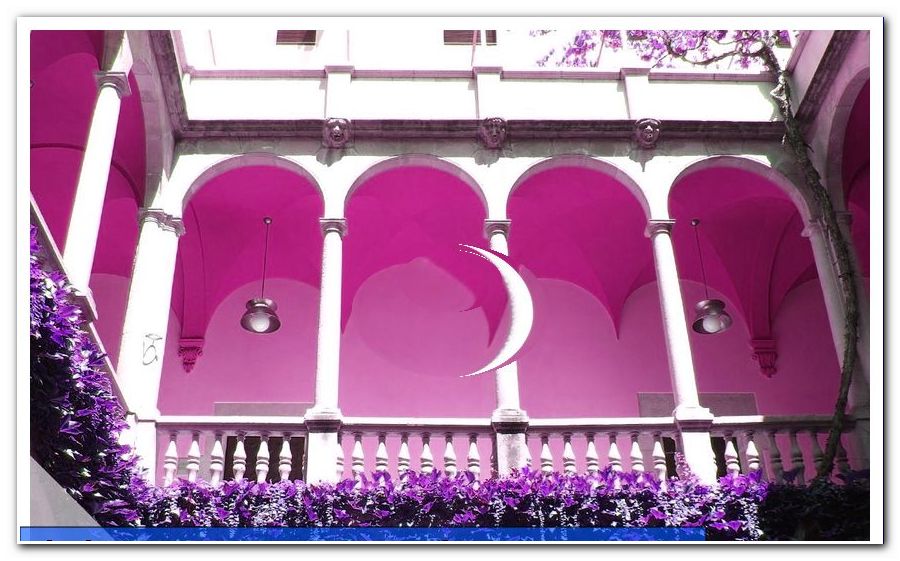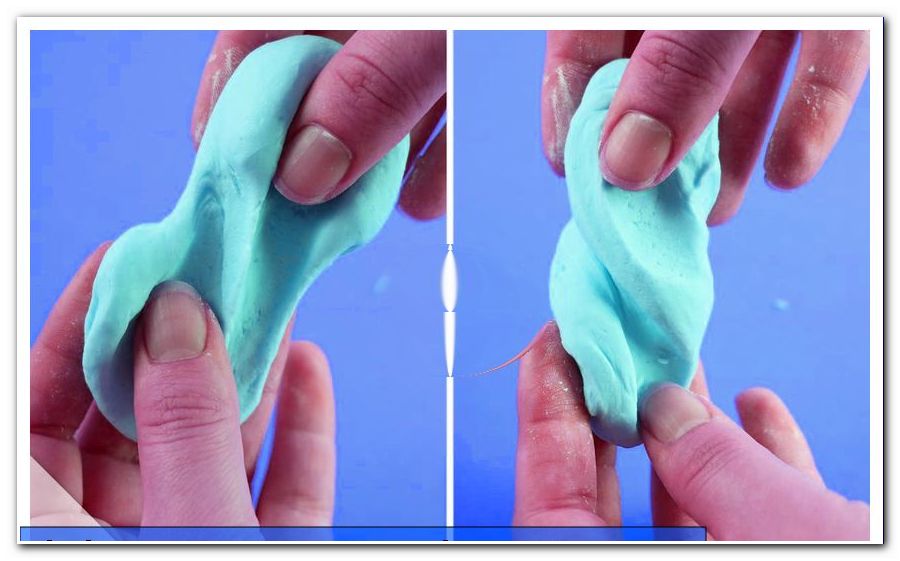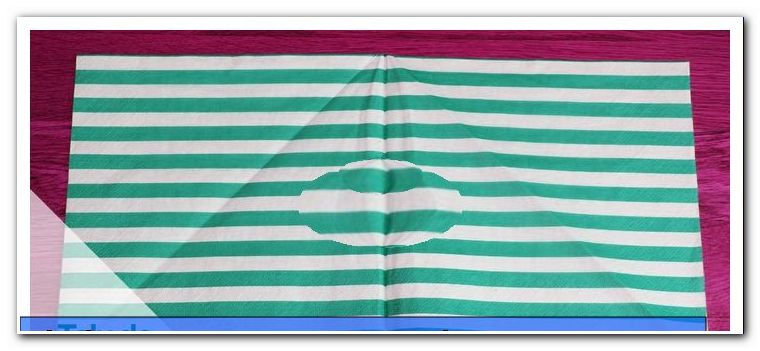Which mineral plaster for facades - mineral plaster or silicone resin plaster?

- Function - surface plaster
- Thermal Insulation Composite System
- Advantages and disadvantages of mineral plasters
- Advantages and disadvantages of silicone resin plaster
- combination
- Tips for quick readers
How a facade is plastered depends essentially on whether it is equipped with an insulation system. Mineral plaster and silicone resin plaster are two types of plaster which offer the best protection and are nevertheless permeable to diffusion. This is indispensable for the preservation of the insulating layer. Both types of plaster have their advantages and disadvantages. Which building material is ideal for what purpose, this guide can clarify.
Function - surface plaster
A finishing coat hides a heavily textured masonry wall and gives it an even and uniform surface. This not only has visual advantages. A plastered wall completes a building to the outside against the weather. Wind and run-off water have less attack points on a finishing coat to cause damage. Before the wall is structurally destroyed by rinsed-out mortar or stones damaged by frost, the plaster layer breaks first. This is noticeable on a plastered wall but immediately and the damage can be repaired quickly and easily. For uninsulated walls plaster is applied in a thickness of 15-20 millimeters. With this layer thickness, the structure of the wall consisting of stones and joints is completely compensated. The surface can be pulled off as smooth as desired.
With insulated walls, the structure of the brick wall is already largely balanced. Especially in old buildings renovation, where an old plaster layer remains on the facade, a balancing of the wall structure through the plaster is no longer necessary. This seduces many contractors and homeowners to make the top coat extremely thin. The reason is the cost. A three-storey multi-family house of ten meters in height, eight meters wide and twelve meters in length has a facade area of approx. 350 m² to be plastered. Three millimeters of additional thickness on the plaster make the construction more than a thousand euros more expensive. However, this is definitely saved at the wrong end.
Thermal Insulation Composite System
The Energy Saving Ordinance stipulates that heated rooms must be insulated with a suitable insulation system to the outside. In new buildings and in the renovation of old buildings with unstructured facades, the exterior insulation is used. This consists of lightweight materials with a high proportion of air. The insulating effect of these building materials depends on how dry they are. Moisturizing by external impact water is therefore just as harmful for an insulating material as non-diffusing condensation water from the inside. In order to keep the insulation dry, exterior plaster must therefore have two properties that are mutually exclusive: they must be waterproof, yet permeable. This can afford mineral plasters and silicone resin plasters.

Advantages and disadvantages of mineral plasters
A mineral plaster is a cement-based, fine-grained material which is pasted or sprayed onto the façade in pasty condition. A high proportion of cement and resistant aggregates of quartz sand give the mineral plaster a high strength. Shrink cracks are prevented by the incorporation of a plaster net or cleaning grid. Mineral plaster is a proven building material for millennia, which is cheap and easy to work with. Mineral plaster can be easily stored in dry silos on the construction site and very efficiently applied to the facade with pumping systems. When finished, Mineralputz absorbs some of the impact water and binds it in its capillaries. The water gradually evaporates after the rain. Moistening of the thermal insulation is effectively prevented by the mineral plaster.
However, the minimum thickness of 2 millimeters has proven to be too thin in practice. Hail or other mechanical impacts could damage the plaster, causing frost damage. Even by woodpeckers picked facades it has already been. The problem here is that the brittle mineral plaster rests on an elastic substrate. In mechanical interventions, the pressure force transfers too quickly to the insulation, as it is not distributed by a thicker layer of plaster on a larger area. It is recorded on too small a cross-sectional area. At the same pressure, a large print area yields only slightly, a small print area all the more. If the surface is too thin, this creates the dreaded fractures that can grow into massive structural damage.
Therefore, the mineral plaster on a thermal insulation composite system should be at least 7 millimeters . A thermal insulation composite system can tolerate an external plaster thickness of up to 20 millimeters. The necessary diffusion openness is still guaranteed by this thickness. The absorption capacity of the mineral plaster of impact water and compressive forces is, of course, much better at this thickness than with the extremely thin plaster layers. However, from 8 millimeters, a two-layered version is recommended, as the thermal expansion stresses in the plaster can otherwise lead to damage. Mineral plaster expands under heat and contracts again on cooling. The resulting stresses can cause cracks, into which water first penetrates and then causes frost damage.
A disadvantage of the mineral plaster is that it is only available in a very limited color selection. The color is determined by the cement and the aggregates. Cement has a gray color, which can be colored by the choice of suitable supplements something in the reddish, white or yellow. If the cement color does not correspond to the taste of the building owner, the facade must be painted in the desired color. When dismantling the building, mineral plaster is not critical. It can be recycled or easily dumped. For thermal insulation composite systems, care must be taken when painting a facade clad with mineral plaster that open-pored paint is used. The diffusion-openness of the façade must not be jeopardized by the color.

Too thin an order on thermal insulation composite systems, mineral plasters have also proved to be susceptible to algae and fungal attack. The plaster itself does not provide the breeding ground for mold and lichen, but organic substances applied by wind, such as pollen and spores. Algae and mold are formed mainly on the north side, since the low ability to heat storage of too thin plaster cools the wall strongly. Dew water stays on thin, combined with thermal insulation composite plaster layers long enough to promote a permanent algae and mold growth.
Overall, however, mineral plaster is a very durable material that can last up to 100 years without damage to a facade.
High-quality mineral plaster costs about 1 Euro per square meter and millimeter layer thickness. In addition there are costs for paint (about 0.32 euros per square meter) and plaster reinforcement fabric (about 0.80 euros per square meter). All in all, you have to assume per square meter of external plaster with a recommended minimum thickness of 7 millimeters of approx. 8.50 per square meter. There are also costs for tools and scaffolding. But since the costs incurred in the silicone resin plaster in the same amount, the costs are not listed here.
In summary, mineral plaster has the following advantages and disadvantages:
| advantages | disadvantage |
| + Inexpensive + Proven + Easy to store and process + very effective and durable, if applied in sufficient thickness | - must always be redrawn - very susceptible to cracking if the order is too thin - Susceptible to mildew if the order is too thin |
Advantages and disadvantages of silicone resin plaster
Silicone resin plasters do not use cement as a binder but a special synthetic resin. In addition, they have as aggregate wholly or partially plastic granules. These are quite new materials, for which there is still no universal standardization. Similarly, as with tools for the designation of "chrome vanadium steel" only a little chrome and vanadium must be stirred into the metal, even the smallest addition of silicone resin is sufficient to make a normal mineral plaster a silicone resin plaster. To really get a high-quality and effective material, the competent study of the data sheets is necessary.
Silicone resin is more elastic and impermeable than cement-based mineral plasters. This promise silicone resins some advantages. Water rolls off and is not absorbed. This keeps the facade dry enough to be resistant to mold and algae. In the case of mechanical stress, for example due to hailstones or balls from playing children, silicone resin plaster reacts elastically. Especially with thin application and thick thermal insulation composite system, silicone resin plaster copes better with mechanical stress than mineral plaster.
Silicone resin plaster can be ordered in many colors. The cleaning material is dyed through. Scratches, for example, by ajar bicycles, do not fall on and must not be painted over. An additional coat of paint is not necessary when using silicone resin plaster.
Silicone resin plaster, however, is much less permeable than a mineral plaster. When using silicone resin plaster, there is a risk that the insulation layer will become moistened from the inside to the outside. This reduces their effect and sooner or later provides thermal bridges to the interior of the building. The consequences can then be increased heating costs or even a formation of mold.
Silicone resin plaster costs much more than mineral plaster because of the pure material costs. An order of about 2 millimeters already costs 7 euros per square meter. For this silicone resin plaster but must not be repainted. However, the cost disadvantage is to be seen in relation to the recommended thickness of the plaster: For silicone resin plaster two millimeters are sufficient, for mineral plasters 5-7 millimeters are recommended. This relativises the cost advantage of the mineral plaster again. The smaller layer thickness of the silicone resin plaster lies in its greater elasticity. This plaster reacts elastically under mechanical load and springs back again.
The silicone resin plaster has these pleasantly elastic properties only when it is new. As soon as it is permanently exposed to sunlight, the plaster will become brittle over time. Especially the hard UV radiation is dangerous for the silicone resin plaster. Also, the weather side of the house is unsuitable for the silicone resin plaster, since the plasticizers, which are responsible for the elasticity, are washed out faster. This can only be prevented if the plaster surface is regularly provided with a protective coating. Silicone hard plaster is a plastic, which does not have the good recycling properties as mineral plaster.

In summary, silicone resin plaster has the following advantages and disadvantages:
| advantages | disadvantage |
| + Can be applied in thin layers + Water repellent + Resistant to attack by mold and algae + Through-dyed, therefore no additional painting necessary + Uncritical with scratches + Mechanically resilient due to high elasticity | - Composition is not standardized - High level of expertise necessary. - gradually loses its mechanical properties - Disposal after dismantling difficult than with mineral plaster |
combination
The latest fire protection considerations plan to equip polystyrene insulated facades with fire bars. These separate the individual floors from each other on the outside, so that a fire can not spread over the façade on the whole house.
It is to be expected that these bars will be executed in such a way that they are always visible. For the selection of the upper plasters this has great advantages. The optical break in the facade makes the combination of different plaster materials much easier.
Mechanical influences on the plaster are to be expected especially in the base area up to the first floor on the traffic side. There, the use of silicone resin plaster is recommended.
Similarly, the shaded north side of a building is better equipped with a silicone resin plaster than with a mineral plaster. The risk of mold or algae infestation is thereby reduced. However, attention should be paid to the diffusion-openness of the material at this point. Otherwise, you move in the worst case, the mold growth only inward.

The rest of the house can be covered with cheap mineral plaster. Only the color, if you really want a same-colored facade, must be adapted to each other.
Tips for quick readers
- Read datasheets of silicone plasters carefully
- Get the best results with a combination of brushes
- Apply mineral plaster sufficiently thick.
- Consider aging effects in silicone resin plasters




